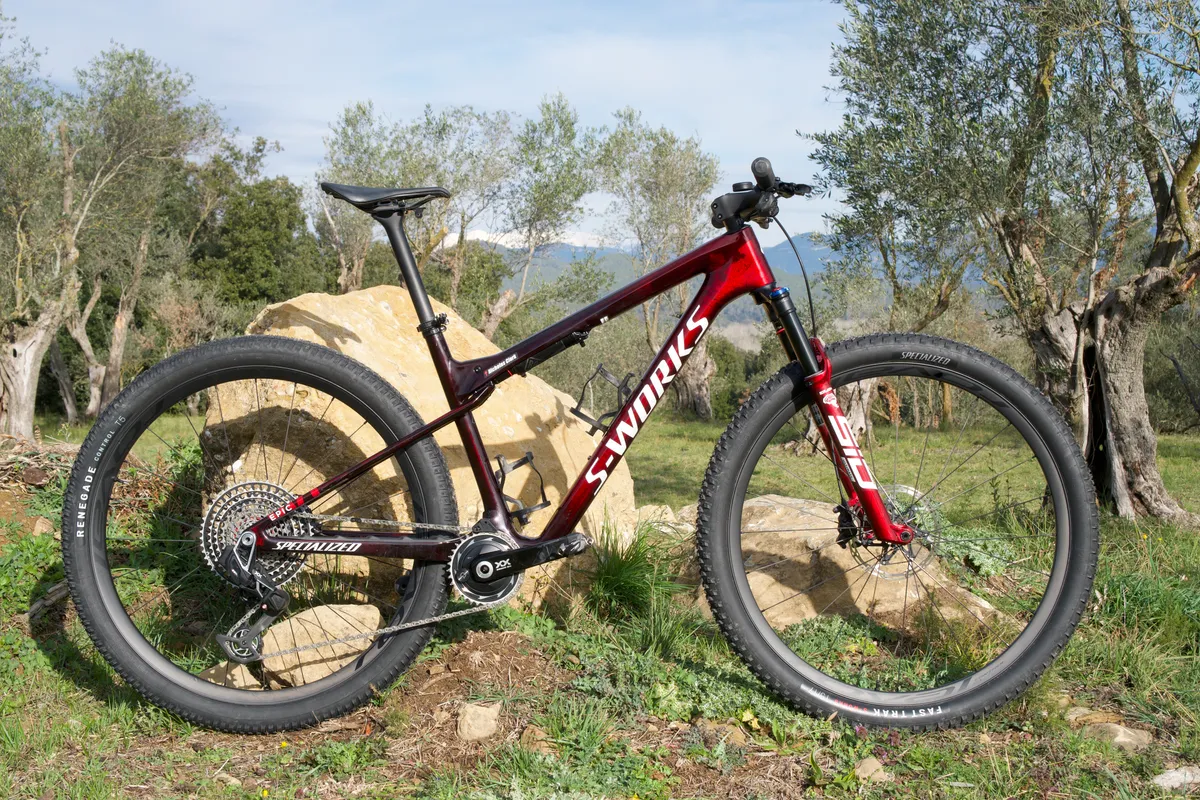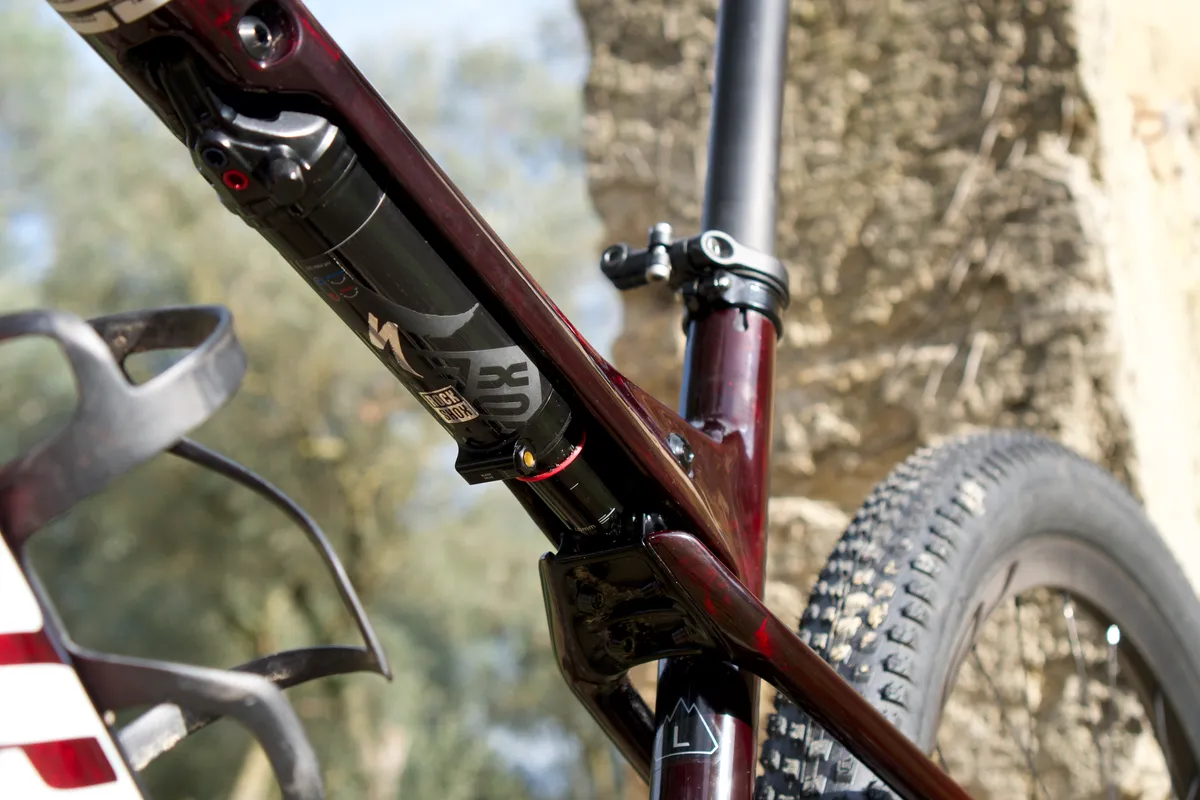The new Epic World Cup features a hardtail-esque silhouette many will liken to the Trek Supercaliber. Both bikes integrate the rear shock into the frame's top tube.
While the Trek uses IsoStrut suspension developed alongside Fox, which utilises flex in the rear seatstays, Specialized’s Epic World Cup has a more traditional shock and linkage design.
The new bike sees the departure of the Brain from the frameset, which was Specialized’s adjustable inertia valve system that firmed up the rear shock while allowing it to break free on impacts.
With the intention of killing off hardtail mountain bikes from cross-country racing, the introduction of the Epic World Cup means Specialized will no longer produce an Epic Hardtail above the Comp level.
Specialized has given the Epic World Cup a more aggressive geometry, but has gone against the grain by providing its race-bred cross-country bike with only 75mm of rear travel. So, can it keep up with the 120mm bike in the field?
Specialized Epic World Cup S-Works frame details

The Epic World Cup is only available in Specialized’s two highest spec levels – S-Works and Pro, though an Expert is expected down the line.
I tested the flagship S-Works model with the higher-modulus FACT 12m carbon frame. Specialized say this frame weighs 1,756 grams for a size medium, including the shock and hardware.
That’s a claimed 110g lighter than the Pro frameset, which uses FACT 11m carbon.
The bike's geometry has changed to adapt to ever more technical cross-country courses. The head angle is one degree slacker at 66.5 degrees than the regular full-suspension Epic.
Seat tube angles have also slackened, from 75.8 degrees to 74.5 degrees.
| S | M | L | XL | |
|---|---|---|---|---|
| Stack (mm) | 600 | 600 | 614 | 628 |
| Reach (mm) | 415 | 440 | 465 | 490 |
| Head tube length (mm) | 93 | 95 | 110 | 125 |
| Head tube angle (degrees) | 66.5 | 66.5 | 66.5 | 66.5 |
| Bottom bracket height (mm) | 313 | 313 | 313 | 313 |
| Bottom bracket drop (mm) | 58 | 57 | 57 | 57 |
| Trail (mm) | 113 | 113 | 113 | 113 |
| Fork length (mm) | 516 | 516 | 516 | 516 |
| Fork offset (mm) | 44 | 44 | 44 | 44 |
| Front center (mm) | 701 | 726 | 757 | 788 |
| Chainstay length (mm) | 430 | 430 | 430 | 430 |
| Wheelbase (mm) | 1,124 | 1,150 | 1,181 | 1,212 |
| Standover height (mm) | 761 | 764 | 774 | 786 |
| Seat tube length (mm) | 395 | 410 | 450 | 500 |
| Seat tube angle (degrees) | 74.5 | 74.5 | 74.5 | 74.5 |
A no Brainer

Where some brands have increased rear suspension on their cross-country bikes, the Epic World Cup has gone the other way, decreasing from 100mm to 75mm.
The RockShox SIDLuxe WCID (World Cup Intergraded Design) shock has been developed in a partnership between Specialized and RockShox, seeing a move away from Specialized’s Brain suspension system.
The new shock enables you to set the pressure of the negative air spring, which when set to a low pressure makes it hard for the shock to initially be compressed.
This is set by a button valve on the shock's body that allows air from the positive chamber to leak into the negative.

The shock can be set up in three modes, which the brand calls ‘Gulp’ settings. This refers to how much air is in the negative chamber, which controls how much force is required to initiate the travel.
These settings can only be changed off the bike and require a shock pump to put air into the positive chamber, which can then be leaked into the negative chamber using the release button on the air can.
Specialized says custom flanged jounce bumpers, which are rubber bumpers placed at the end of the shock damper, provide an aggressive hook at the end of the stroke to manage bottom-out on big impacts.
For more information on the Gulp settings, read our news article on the Specialized Epic World Cup.
Specialized Epic World Cup S-Works specification details

This flagship Epic World Cup features Specialized’s own carbon Roval Control SL wheelset, which features a 29mm-wide internal profile and has a claimed weight of 1,240g.
The wheels are booted with Specialized’s 2.35in Renegade Control T5 tyre at the rear and a 2.35in Fast Trak S-Works T5/T7 up-front.
RockShox provides the suspension, in the form of a RockShox SID WCID rear shock and a 110mm SID SL Ultimate Brain front fork.

The new fork uses an updated Brain damper and features a CNC’d crown for weight savings, giving the fork an almost skeletal look.

SRAM’s XX SL Eagle T-Type AXS drivetrain features alongside the new Level Stealth brakes, which run the cables of the brakes closer to the handlebar.

Specialized’s new Roval Control SL Cockpit integrates the bar and stem. The bar features a bolt for a computer mount, with a back sweep of 8 degrees, and has no bar-roll adjustability. Specialized claims it tips the scales at 250g for a 70mm stem and 780mm bar.
The Control SL Seatpost is 415mm in length and is held in place by a 2-bolt micro-adjustable seat collar clamp. The brand claims this weighs 180g.
Specialized Epic World Cup S-Works ride impressions

I tested the Epic World Cup over three rides around Girona in northern Spain, alongside some seasoned pro and semi-pro cross-country riders, who quickly humbled my efforts with nonchalant questioning up steep climbs.
The trails were a mix of tacky and wet mud, with long climbs and descents attacked with the vigour of an enduro racer – regretfully forgoing the knee pads.
I hope to get the Epic World Cup back in the UK for a full review, to see how it performs on home trails with British weather.
Specialized Epic World Cup S-Works climbing performance

Climbing is traditionally the most important factor when it comes to cross-country bikes, and it is an area where Specialized has evidently spent a lot of its time with the new Epic World Cup.
The combination of the Renegade and Fast Track 2.35in tyres, and the Roval Contact SL wheelset provided the bike with direct liveliness under acceleration, while offering good levels of grip on everything from wet rocks to gravel singletrack.
The 29mm internal rim width and the 2.35in tubeless tyres enabled me to run lower tyre pressures, deciding on 22psi in the rear and a whisker over 20psi in the front.
Low air pressure and a supple carcass helped the tyre conform over rocky ascents, making it difficult to break traction on even the slickest rocks.
Hard Gulp

The 75mm RockShock SID WCID shock provides the Epic World Cup with an excellent pedalling platform, though I initially struggled to find my sweet spot with the suspension.
In the firm No Gulp setting, the shock has zero sag due to the negative air chamber being empty. Pedal bob is virtually eliminated in this setting, giving the bike the feeling and responsiveness of a hardtail even when smashing the pedals out of the saddle.
Specialized says the firm setting is best used on smooth terrain, and it provides the firmest and most snappy feel.
I found it very efficient when climbing, especially on fire roads, where the rigid feel of the bike turned pedal strokes into easy elevation gain.
Because a little persuasion is required to initiate the travel, it mimics a hardtail when on rough terrain too, resulting in a loss of grip on rough sections of uphill. The rear wheel bounced and slipped over roots and rocks, relying solely on the tyre's grip.
I used the medium Half Gulp setting the most because I found it more balanced and it complemented slightly rougher trails better.
In this setting, less force is needed to activate the suspension, which helped me find more grip on steep climbs, while still giving a hardtail-like feel on smoother ascents. For most of the cross-country riding I do, this would be the Goldilocks setting.
As with the Brain system on the previous model, there is no complete lockout or remote setting of the bike. This set-and-forget system enabled me to think more about line choice before tackling uphill sections rather than button location, which was especially helpful after three hours of tasting my own lungs.
While the Brain may be dead on the rear shock, it lives on in the fork and provides good support for out-of-the-saddle efforts.
The geometry of the bike is well suited to climbing, keeping your body weight nicely centred over the pedals.

A long reach gives plenty of room to move about on the bike, enabling you to move forward and back to find traction over obstacles.
SRAM’s XX T-Type Eagle AXS performed faultlessly, enabling me to shift gears without lifting off the power.
The Stealth brakes also made holding the bars further inward feel more stable because my hands were placed more naturally over the levers. This made long fire-road climbs a little less taxing on my upper body.
Specialized Epic World Cup S-Works descending performance

The Epic World Cup really doesn’t feel as though it has 75mm of rear suspension, with slack geometry making the bike feel confident and capable when descending.
The firm setting descends well when compared to a hardtail, taking the edge off large impacts, though on rougher terrain the rear of the bike felt skittish under braking, especially on looser surfaces.
In the medium setting, this was noticeably less of a problem, and the relatively aggressive geometry made it easy to get the bike back into shape in both settings.

The stiffness of the bike added to my confidence, enabling me to place it accurately on the trail even through a memorably gnarly rock garden.
I found the active mode to be the best for descending, with the bike feeling almost like a mini trail bike and the high seatpost not stopping me from getting the bike into the air.
The geometry was very compelling considering the amount of travel on tap – forcing me to find the limit by crashing hard on a rock slab.

Specialized has kept the chainstay lengths short at 430mm, with the bike feeling playful and eager to change direction, while the longer front centre makes it stable through steep corners and rugged sections.
The Fast Track front tyre was grippy on gravel and rock, though the small side knobs met their match on muddy trails.
I found Specialized’s new Control SL Cockpit quite stiff, and the flared hand position took some getting used to when descending because the bars put you in a cruiser-like position, though I found they added comfort on longer days out.
Based on my initial experience, the Specialized Epic World Cup is a very capable performer on the terrain I rode. It seems to tick all the boxes an XCO bike should.
Product
| Brand | specialized_bicycles |
| Price | 12500.00 EUR,12000.00 GBP,12000.00 USD |
| Weight | 1756.0000, GRAM (Medium) - (medium sized frameset, including shock) |
Features
| Fork | RockShox SID SL ULTIMATE BRAIN |
| br_chain | SRAM XX SL Eagle |
| br_frame | Specialized S-Works World Cup |
| Tyres | Specialized S-Works Fast Trak 29x2.35in (front), Specialized Renegade 29x2.35in (rear) |
| br_brakes | SRAM Level Ultimate Stealth |
| br_cranks | Quarq XX SL power meter crankset |
| br_saddle | Body Geometry S-Works Power |
| br_wheels | Roval Control SL |
| br_shifter | SRAM POD AXS |
| br_cassette | SRAM CS-1299 |
| br_seatpost | Roval Control SL carbon seatpost |
| br_gripsTape | Specialized Trail Grips |
| br_handlebar | Roval Control SL integrated cockpit |
| br_rearShock | RockShox-Specialized SIDLuxe WCID Ultimate |
| br_bottomBracket | SRAM DUB, BSA 73mm, Threaded |
| br_availableSizes | S, M, L, XL |
| br_rearDerailleur | SRAM XX SL Eagle Transmission |
